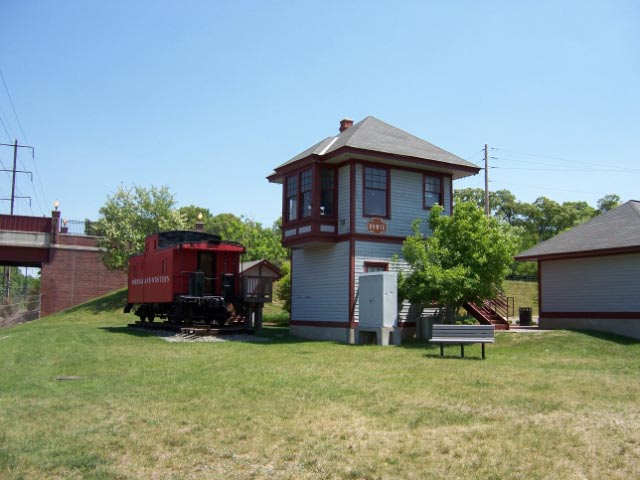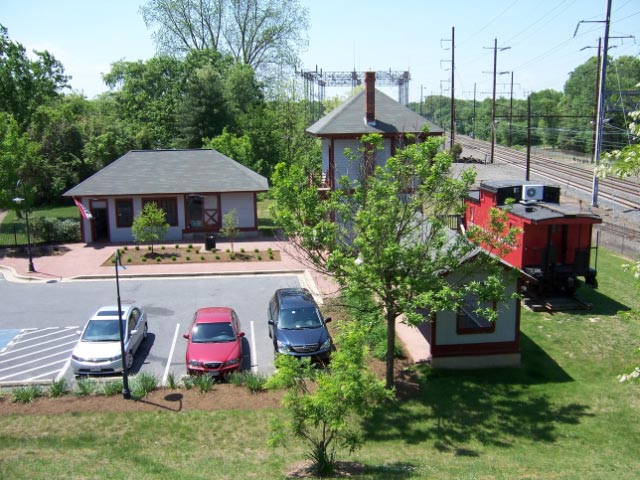Huntington Railroad Museum






All photos copyright © William E. Smith
The museum consists of three railroad structures: switch tower, freight depot, and waiting shed. All were moved to the current site from their original nearby locations. In March 2000, a caboose was moved from Allen Pond Park in Bowie to the museum site.
History
 Colonel
William Bowie, and his family, were granted a charter in 1853, to
construct a railroad from Baltimore to Southern Maryland. Oden Bowie
became the first president of The Baltimore and Potomac Railroad
Company. A provision in the charter permitted lateral spurs not to
exceed twenty miles. Construction of the railroad was delayed until
after the Civil War. Shortly after construction began, Oden Bowie was
elected Governor of Maryland in 1869.
Colonel
William Bowie, and his family, were granted a charter in 1853, to
construct a railroad from Baltimore to Southern Maryland. Oden Bowie
became the first president of The Baltimore and Potomac Railroad
Company. A provision in the charter permitted lateral spurs not to
exceed twenty miles. Construction of the railroad was delayed until
after the Civil War. Shortly after construction began, Oden Bowie was
elected Governor of Maryland in 1869.
Ben Plumb, a land speculator and developer, learned of the new railroad. In 1870, he purchased 300 acres near the planned route. He named the area Huntington City and sold 125' by 20' lots for $25.00 and $30.00 each. Streets were laid out with east-west numbered streets and north-south streets named after trees.
The Pennsylvania Railroad wanted a route from Baltimore to Washington, D.C. However, the railroad's request for such a route had been denied by Congress. The Pennsylvania Railroad knew of the provision in the charter of The Baltimore and Potomac for spurs, and made an agreement with The B&P to construct their lines. By routing the main line from Baltimore to Pope's Creek through Huntington City, a lateral line could then be legally built to Washington. Congress granted permission for the spur to be built. The Pennsylvania Railroad bought half of the B&P stock, and incorporated the B&P into their system on November 1, 1902.
Trains began running from Baltimore to Washington on July 2, 1872. Trains started running to Pope's Creek on January 1, 1873. A trip from Bowie to Pope's Creek cost $1.95 at that time. The station at Huntington City was named Bowie after Oden Bowie. The Town of Huntington was incorporated on March 3, 1874. In 1882, the name of the town was changed to Bowie in honor of the family that worked so hard in getting the railroad constructed. The Belair Estate was annexed to Bowie in 1959.
In October, 1910, a fire destroyed all of the buildings at Bowie Station. This also included the entire business district.
The present switch tower was constructed in 1920 by The Pennsylvania Railroad to operate the new interlocking. The freight depot and waiting shed were constructed a few years later. The line from Baltimore to Washington was electrified in 1935. A third track was added in 1940.
The Museum
Bowie Station was closed in 1989 and was replaced by the new Bowie State Station. In 1992, the City of Bowie purchased the museum's buildings, and had them moved to their present location. They were renovated with a grant from The Maryland Historical Society, and with city funds.
The main line now carries Amtrak Northeast Corridor Service trains and MARC commuter trains. Coal trains, now operated by CSX, use the Pope's Creek line.
The freight depot contains a collection of railroad artifacts. The first floor of the switch tower has an exhibit of historical photographs. The second floor of the switch tower has additional artifacts as well as a view of the Amtrak mainline.
Reference:
Town of Bowie, Maryland, 1870 - 1960, Huntington Heritage
Society, Inc.